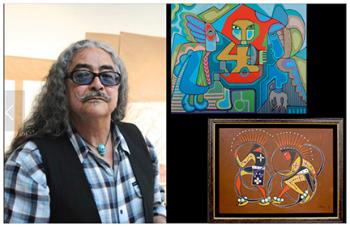Image Caption
Local Journalism Initiative Reporter
Windspeaker.com
Joseph Sánchez is co-curating the upcoming exhibit The Ancestors Are Talking: Paintings by the Indigenous Seven at The Whyte museum located in Banff, Alta. from May 3 to Oct. 19. The exhibit features 77 works.
Sánchez is the last living member of the Indigenous Group of Seven. The group consisted also of Jackson Beardy, Eddy Cobiness, Alex Janvier, Norval Morrisseau, Daphne Odig and Carl Ray.
Co-curators are The Whyte's curator of Indigenous initiatives Dawn Saunders Dahl and Christina Cuthbertson, the director of curatorial initiatives.
Sánchez and the Indigenous Group of Seven established Professional Native Indian Artists Inc. (PNIAI) in the early 1970s. They set out to change the way Indigenous art was viewed by Canadians and the world. Their intention was to move Indigenous art from being categorized or viewed as handicraft into the perspective of contemporary modern art.
Members had their own individual artistic styles that reflected their various cultural backgrounds. Collectively, they were determined to work towards having Indigenous art showcased at exhibitions and fine art galleries.
Additionally, the group was passionate about clearing the path for future artists and, as part of their group philosophy, they decided to take a portion of all the money they raised through sales of their work to mentor upcoming Indigenous artists.
At the time of PNIAI’s incorporation, Sánchez was only 22 years old.
Now 77, with all of the other members passed away, Sánchez wanted to curate an exhibit that brought all seven artists’ work to display from the beginning of their inception and throughout their careers.
“It’s really exciting,” Sánchez said. “One that kind of will transcend some of the early negativity about the group, that it was simplistic or whatever. But that was 55 years ago… A lot of artists have benefited from the fact that this group existed and broke that feeling and that’s what I think people need to kind of understand when they look at this work, that it did break barriers so long ago.”
Though the group worked together behind the scenes, their work wasn’t often shown together.
“Three of them have had a one-person show at the National Gallery,” said Sanchez, adding they were considered masters. Now he wants to show that all of the members were masters in their own way.
The only gallery in Canada where all seven artists’ work has been displayed together was at the Museum of Aboriginal Peoples’ Art & Artifacts located in Lac La Biche, Alta. The museum houses nearly 2,000 Indigenous artworks and artifacts.
For the upcoming show at The Whyte, Sánchez was able to borrow items from each of the artists’ personal collections, as well as from private collectors.
“Some of the works had never been seen at all,” explained Sánchez. “They went directly from the artist to the collectors so it’s going to be a lot of that kind of stuff in there, work that you’ve never seen before.”
But highlighting work from the group is not the only intention of the exhibit. Sánchez is also looking forward to having the opportunity to show how each of the artists influenced each other.
“This show will definitely focus on how, if you look close enough, you’ll see the influence of the older artists to the younger artists,” he said.
A few of the artists passed away many years ago, while others lived up until recently.
Odjig, who passed in 2016 was 97 years old.
“Daphne kept painting all the way up to the end,” Sánchez said. “She was drawing on her last day of her life.”
This vast array of work throughout the years was the driving force behind the exhibit.
“I wanted people to see the work, the full spectrum of the work that was created,” Sánchez said. “Not just this Indian work from the 1970s because basically the group was founded to stop that designation, that we were Indian artists.”
“I want to share new insights into this work with the public,” Sanchez said.
Prior to Morrisseau’s passing, he said Sanchez was one of the only people still alive with a true understanding of each of the artists’ work.
“(He said) I’m one of the only people still alive that understands what these symbols and these works mean, so it’s important that we share that,” explained Sanchez. “It’s quite more of an open-eyed look at the work … and also the work had lots to do with healing. Not only healing of our people but healing of the whole nation.”
The entire philosophy of the group was “this idea that we should help each other, and we should also take our work to our own people … We need to share it with our young people to help their cultural awareness.”
To honour this aspect, Sanchez and The Whyte administration wanted to tie the exhibit to an opportunity for young artists to learn from Sánchez.
“I’ve invited all of the mural artists who have been working on various murals on the museum grounds… to come back and work with Joseph for four days to spend some time with Joseph on the show and then be inspired by those works (to create their own) and we would show that exhibit next year,” said Saunders Dahl. “So, we’ll give them about a year to create new works and then we will show them the following year. It’s about keeping that legacy going.”
Sánchez said he has been preparing for the exhibit since his inclusion into the group and is looking forward to finally being able to bring it to life.
“As it turns out, you know, like Norval said, I’d be the last one living and I would carry the work. I would be able to share the work with the wider audience and that’s just what I’m trying to do,” said Sánchez.
Local Journalism Initiative Reporters are supported by a financial contribution made by the Government of Canada.

